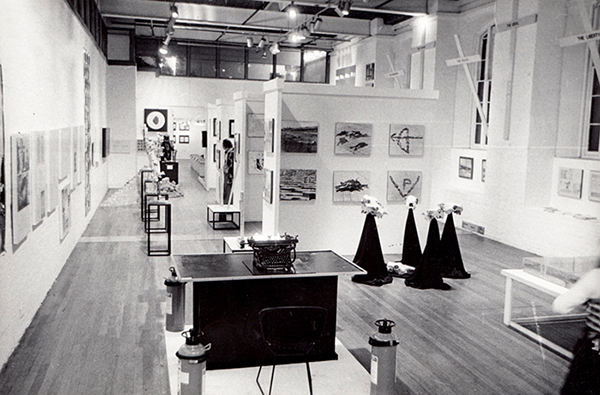Exhibitions at the Centro de Arte y Comunicación (CAYC) took many distinct forms over the years. Since the first one, Arte y Cibernética, in 1969, the Center showed a preference for group shows that provided a panoramic view of trends. The CAYC had already developed internal and external networks of artists and institutions. Some preexisting kinds of Argentinean art from the 1960s, like “art in the street,” experimenting with new technologies, and interdisciplinary practice, continued and thrived as part of the Center’s activities. Those movements were an essential part of its poetics, especially in the early years.
In 1970 the CAYC organized De la figuración al arte de sistemas (doc. no. 761141)—an exhibition featuring works by Luis Fernando Benedit, Nicolás García Uriburu, and Edgardo Antonio Vigo—and, the following year, the international exhibition Arte de sistemas. Both of these events helped to develop a local and international genealogy of the category that started it all, “arte de sistemas.” With that in mind, Glusberg assigned objects and various artistic manifestations to Jack Burnham’s theories about “system esthetics” (1968). Structuralism, information science, conceptualism, arte povera, and international situationism fueled this category. “Arte de sistemas” therefore made it possible to generate an aesthetic reading of natural and social environments as a set of closely related elements. Seen from that perspective, processes took the place of “finished products of fine art,” as Glusberg put it. Statistics, diagrams, and interventions revealed the mechanisms of the art system and other mechanisms related to various aspects of society. The CAYC therefore championed “arte de sistemas” as a means to create a kind of regional art that speaks an international language.

The CAYC took an innovative approach to the task of producing exhibitions. It standardized each artist’s contribution according to formats and techniques that facilitated the circulation of works and the chance of them being shown more than once. This strategy is reminiscent of mail art, which was pioneered and introduced in Argentina by Vigo, mentioned above, a regular contributor to the CAYC. Objects made of “poor” materials and pages/originals reproduced with a heliographic stamp were some of the simple (and economical) resources that fostered the idea of traveling shows. Similarly, newsletters, brochures, and catalogues document the spirit of those activities.
Several guest artists at CAYC exhibitions formed the group with which the Center sought to launch a “new avant-garde:” the Grupo de los Trece, which included (until 1975) Jacques Bedel, Luis Fernando Benedit, Gregorio Dujovny, Carlos Ginzburg, Víctor Grippo, Jorge González Mir, Vicente Marotta, Luis Pazos, Alfredo Portillos, Juan Carlos Romero, Julio Teich, Horacio Zabala, and Glusberg. The group called itself a laboratory devoted to “thinking about the future and taking action.” Its first event was Hacia un perfil del arte latinoamericano, where this exhibition strategy took shape. Its goal was to produce art that identified the region, reflecting the problems that were common to underdeveloped countries. In the process, “arte de sistemas” gradually became a political kind of art, jointly developed by artists from Latin America and elsewhere who pondered the Third World’s economic dependence and political systems, the establishment’s power over people and the environment, and similar issues that were the subject of debate in those days. The CAYC’s exhibitions were shown in Latin America, Europe, the United States, and Japan. To keep up with those traveling shows, whose exhibition schedules sometimes almost overlapped, the CAYC relied on “thematic modules” consisting of works that were available for flexible, open curatorial plans that could be adapted to the material or symbolic needs of the host location.
The CAYC was interested in multimedia art installations, video art festivals, non-commercial films, and performance art because of the new technology and supports that were involved, as could be seen in the Center’s continued support for experimental art in its exhibitions and publications.

1977 was a pivotal year for the CAYC and its exhibitions, the year when the group event Signos en ecosistemas artificiales was presented and the Grupo CAYC [1] was awarded the Grande Prêmio Itamaraty (MRE) at the São Paulo Biennial. Inspired by the binary relationship between natural and artificial, the installation evoked the category that had defined the CAYC’s aesthetic and crystallized the poetics that the group had been expressing in its various activities for almost a decade. It was, in fact, the last time that Glusberg presented a work based on “arte de sistemas.”
The exhibition was conceived as a grand “semiotic complex” in which each artist’s works functioned as texts that presented their meanings (“rhetorical variations” on a single set of themes) to be interpreted by viewers, by readers. The group was assigned 800 square meters in the iconic pavilion designed by the Brazilian architect Oscar Niemeyer at the Parque do Ibirapuera, where it presented an array of innovative strategies that, in the Southern Cone at least, were still unheard of. The concept of an “installation,” as it subsequently evolved in Argentina, derived from the semiotic reading provided by Glusberg and other critics in those days. That exhibition also defined the role of “curator” as we know it today.
NOTES
1. The group became known as the Grupo CAYC after its list of members shrunk to nine: Bedel, Benedit, Grippo, Glusberg, Maler, Marotta, González Mir, Portillos, and Testa.
